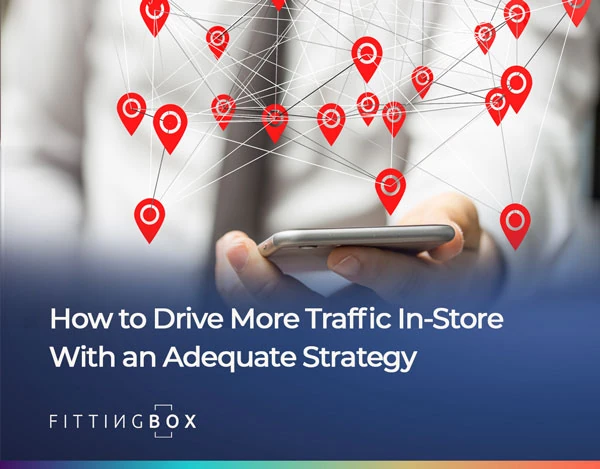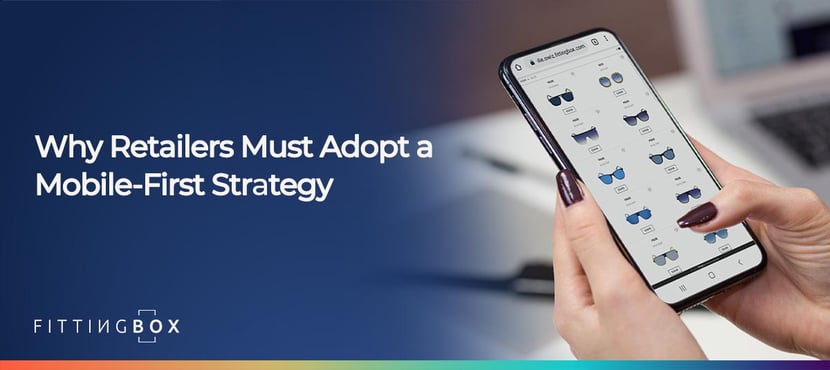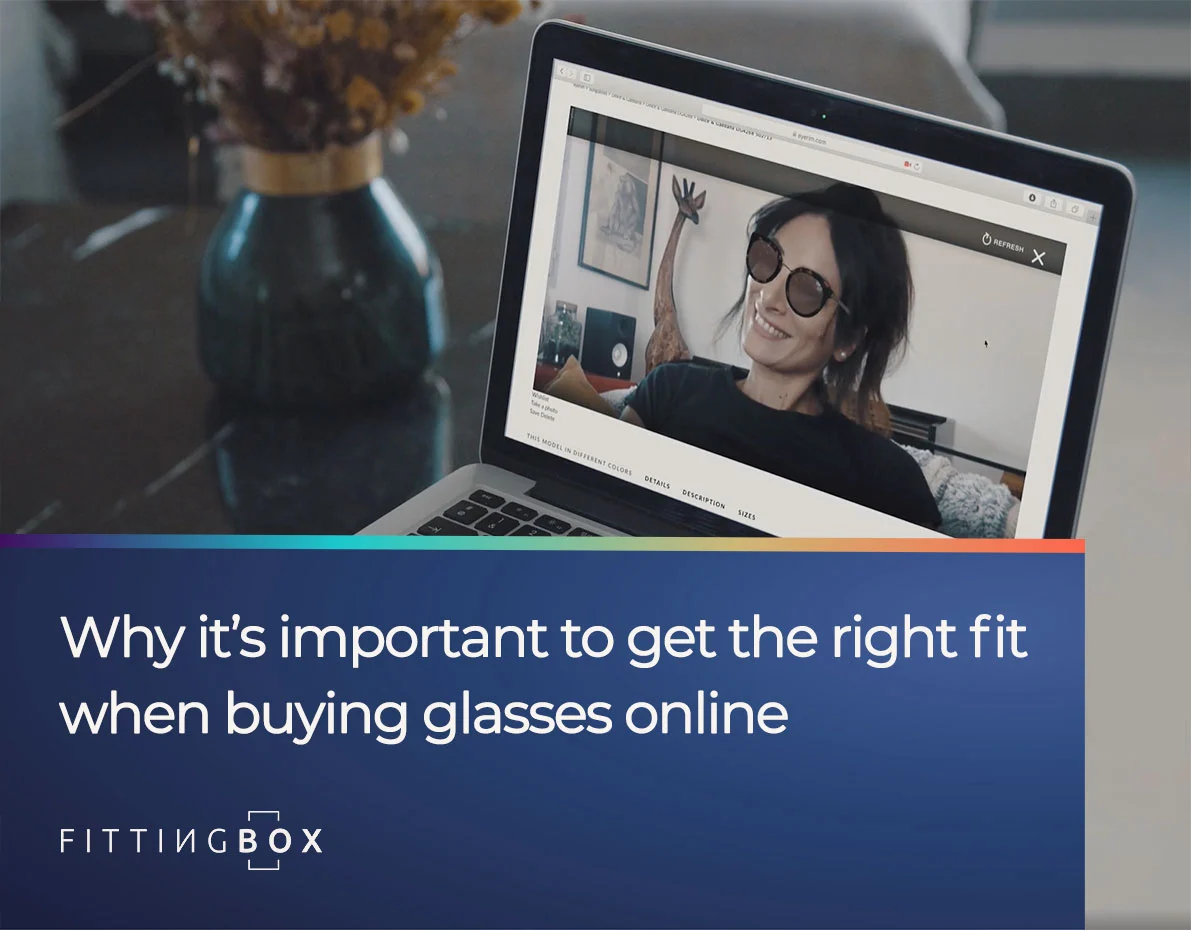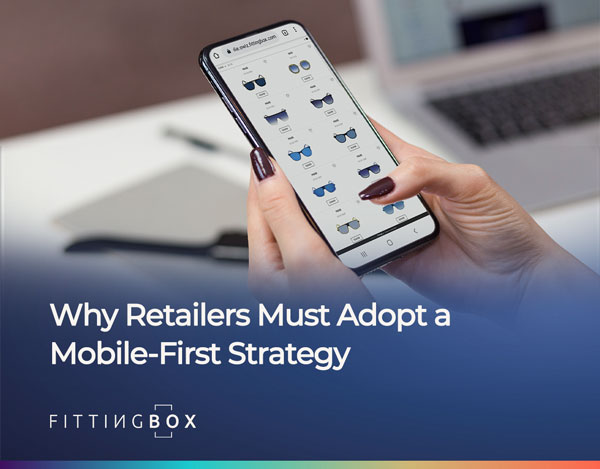
Why Retailers Must Adopt a Mobile-First Strategy
Are you reading this article on your cell phone? Chances are if you’re like most people on the planet, you spend most of your free time online – with your mobile device in hand.

Consumer preferences and buying trends evolve over time, and for the past decade or more, customers have stayed increasingly connected to the world via smartphones. Since approximately 2014, depending on where you are located in the world, internet consumption has been mobile-first. However, many retailers have not yet invested in a mobile-first strategy to meet customers where they are – on their devices. That’s particularly true when it comes to shopping for glasses online.
Eyewear Retailers, like other online players, must adopt a mobile-first strategy to remain competitive within the eyewear industry because, without a mobile-friendly presence, customers will find a retailer who has one – with a simple scroll.
What is a Mobile-First Strategy?
A mobile-first marketing strategy places necessary importance on creating mobile-friendly, small screen-sized websites and apps that can later be adapted to desktop computers and laptop screens – instead of the other way around.
Mobile-first, coined by technology and web design experts, takes advantage of a broader network coverage area and optimizes user preferences on their mobile devices. This strategy personalizes user experiences and frequently reaches more users in all environments, from strolling through their local shopping mall to lounging on their sofa at home.
The Benefits of Prioritizing a Mobile-Friendly Customer Experience
While a customer-first approach is king in the marketing realm, there are countless additional benefits to achieving those objectives through mobile-friendly means.
Customer Retention Skyrockets
A massive 79% of shoppers claim to have made online purchases using their smartphones, and of all mobile-driven consumers, a digital app helps to skyrocket customer retention to 66% within a 30-day window.
Customer engagement through these apps and mobile-friendly websites is the key to lengthy retention rates. When customers feel a sense of connection with a brand through their online presence, brand loyalty ensues. In fact, one-third of customers claim that they are dedicated to specific brands.
Increase Brand Awareness
Strategic placement of ads and content on mobile-friendly apps like Facebook, Instagram, YouTube, Google, and others can increase brand awareness dramatically. Let’s be honest, social media marketing produces the greatest results on mobile devices, and limiting 56.8% of the world’s social media users from becoming accustomed to retailer brands seems like a missed opportunity for revenue-boosting marketing strategies.
Studies have shown that consumers that are subjected to a brand’s products, services, and even the retailer’s logo between 5 and 7 times reach the level of "brand awareness," and with more than half of all humans using social media (in addition to retailer apps and other websites), it’s a great place to gain traction.
Data Gathering – First Hand
With a growing demand among the general public regarding privacy, it’s becoming more challenging to obtain crucial demographic information on customer preferences and data. Gone are the days of draining the marketing budget by paying third-party websites for data.
Enticing new leads and current clients to download and use your retail app or visit your mobile-friendly site, each retailer can gather and track consumer trending data from the source. First-hand information from those who have already set foot in their digital space can demonstrate consumer product or brand interest and the likelihood that they will transform from lead into a paying customer.
Some of the metrics retailers can capture in-app, via their mobile website, and through user-approved cookies include:
- Segmented or Cohort Analysis: Separating leads based on varying factors like their position on the buyer’s journey
- Digital Multi-Touch Attribution: tracking where and how many times leads have seen and touched on ads, social media posts, website visits, specific products, etc.
- Predictive Modeling: the process of analyzing the effectiveness of marketing campaigns and predicting future success
How Does a Mobile-First Strategy Impact Search Engine Results?
The world’s leading search engine, Google, places a priority on those websites that cater to the mobile market, pushing them to ranking status on search result pages. In April of 2015, Google developed and implemented an algorithm that favors mobile-equipped websites, and those lacking the format could be pushed down on the priority list.
If a retailer is unsure about whether their website will achieve a high position on Google, the prominent search engine offers a free tool to analyze the site, and when creating a free account on Google Search Console, Google will notify site owners if something were to go wrong with their mobile efficiency.
Evolve into a Mobile-First Omnichannel—Implementing a Mobile-First Strategy is Not Enough
Customers demand seamless experiences from brand awareness to product acquisition. They desire various options for their online shopping excursion and demand simplistic payment methods without the runaround. That’s omnichannel.
So, how do glasses retailers provide exactly what their customers are dreaming of? M-Commerce focuses on a mobile-first omnichannel strategy that complements every other facet of its brand.
When clients can browse your product catalog, shop, and pay from any location and any time of the day and have it either shipped in mere days, picked up the same day in-store, or they can relax in their vehicle during curbside pickup, they develop brand loyalty that keeps them coming back for more.
Mobile-focused sites and purchasing apps offer convenience without sacrificing time. However, for those consumers who still enjoy a physical shopping experience, creating an omnipresence via retailer apps can offer instant perks, suggested products, and easy pay experiences while they browse the aisles.
Conclusion
For retailers looking to keep up with the big boys, adopting a mobile-friendly marketing strategy that lends itself to omnichannel experiences for their customers is a game-changing tactic for businesses of all sizes, digital or brick-and-mortar, and in any location across all 7 continents. The world can be accessed by a pocket-sized mobile device—it’s time to get on board. At Fittingbox, the virtual try-on solution is designed to be mobile-first!
LET'S TALK
Request a demo, a quote or set up an appointment with one of our sales representatives.
CONTACT USUseful Links
Corporate
© FITTINGBOX 2023 • Terms of use • Privacy & Legal




